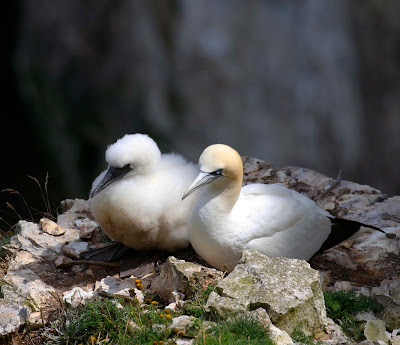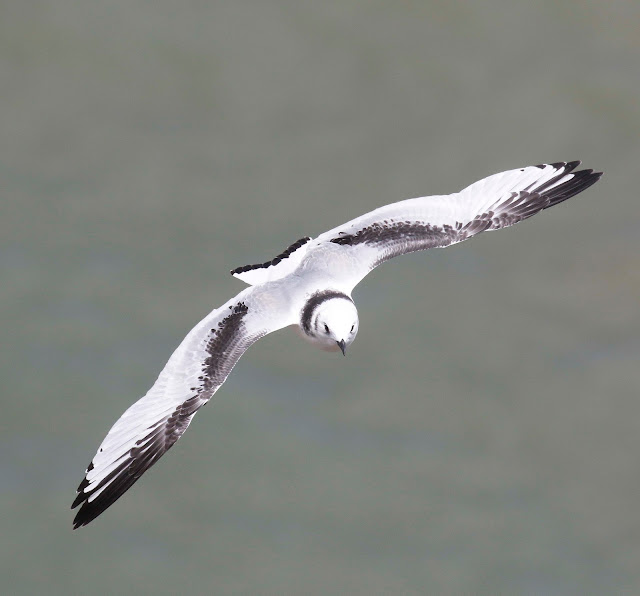Bempton Cliffs is an RSPB reserve in East Yorkshire that is rightly famous and popular with birders and the general public alike for the close views it offers of thousands of breeding seabirds that come every year to nest on the steep cliffs that run for six miles and are 100 metres at their highest point. Gannets, Kittiwakes, Guillemots, Razorbills and Puffins can all be seen from the various viewpoints that have been strategically constructed at the cliff edge to facilitate viewing without disturbing the birds or indeed to prevent people falling to their death.
Last year Bempton Cliffs was visited by a Black browed Albatross which joined the Gannets on the cliffs but sadly failed to return this year. Myself and Mark went to see the albatross no less than six times but this year despite its absence we nevertheless decided to return and spend a couple of days at Bempton photographing and enjoying the spectacle of so many seabirds gathered in one place.
We were a little late going to Bempton this year and most of the auks had departed with only a few pairs of Guillemots remaining to guard their chick whose departure from the cliffs was imminent but Gannets and Kittiwakes were still present in large numbers and we were happy enough watching and photographing their comings and goings.
Britain holds 55%, close to 300,000 pairs, of the world's population of Northern Gannets (their proper name) and up until the arrival of this latest deadly mutation of the avian flu virus numbers were increasing at an estimated 3-5% a year.
Northern Gannets, to give them their correct name, are spectacular birds and at Bempton, their largest mainland breeding colony, one has the opportunity to come very close to them as they cruise along the cliffs, sit on an outcrop preening or display to each other. Many at this time are non breeding birds of various ages (Gannets do not breed until they are four or five years old) but some adults have well grown young which will still require some time to grow before they are ready to leave the cliffs and take their chances.
The huge worry this year, as it was last year, is avian flu and thankfully the Gannets seem to have escaped the worst at Bempton although there were a few dead birds floating in the sea. It only brought home to me how fortunate we were to still be able to enjoy the Gannets and made me appreciate them even more if that were at all possible.
 |
| An adult Northern Gannet |
 |
| A two year old Northern Gannet |
 |
| A four year old Northern Gannet displaying |
 |
| Northern Gannet with its well grown single chick |
 |
| A three year old Northern Gannet |
 |
| Northern Gannet pair's greeting ceremony |
The other seabird species still present in large numbers at Bempton was the Kittiwake or Black legged Kittiwake to give its full name. This was refreshing as a report had recently come through that a section of the cliffs where they breed had been closed off in an attempt to quarantine an outbreak of avian flu. I saw several dead bodies lying in the grass on a remote part of the clifftop but despite this sad sight there were many pairs with two almost fully grown healthy young, perched perilously on their precipitous nests whilst many others, both adults and young were flying around the cliff faces.
 |
An adult Black legged Kittiwake and its two well grown young on their nest platform
A recently fledged Black legged Kittiwake in its first days of independence |
The recently independent young were still trying out and strengthening their wings, flying out from the cliff in endless sorties to circle around amongst the Gannets and adult Kittiwakes, familiarising themselves with the cliffs, getting a feel for the wind currents and practicing landing and departing from the cliffs.Apparently it has been a good year for them, despite the virus, with many adults raising two young to the flying stage and it was a joy to watch the young circling endlesssly back and fore from the cliffs.
The juvenile's plumage is a very attractive combination of white, black and grey. The black on their wings forming a distinctive inverted v shape as they fly.. Small and petite they present an image of fragility but are anything but as apart from this time on the cliffs they will spend the remainder of the year far out to sea until those that survive return next year to breed.
 |
| Juvenile Black legged Kittiwakes |
 |
| An adult Black legged Kittiwake |
My abiding memory apart from the sight of all these birds is the sound of the colony, the combination of the Gannets constant deep rhythmic growling and the Kittiwake's harsh exclamations are the true soul of the colony, the sound rising up from the cliffs below as you wander onto each viewpoint. In the end I tired of taking images and took to standing, pensively looking down on the birds flying over the sea and rejoicing in their presence.
There is one other bird for which Bempton is well known and that is the Tree Sparrow. This is now a species in severe decline throughout Britain. They are all but gone from my county of Oxfordshire despite feeding programmes but Bempton has bucked the trend and the birds are literally everywhere on the reserve and on farmland beyond, cheerfully chirruping and hurtling in excitable flocks across the grass to hide in bushes, chattering wildly. to themselves and even to be found in and around the cliffs where some breed whilst others utilise nest boxes erected for them on the visitor centre's walls.
They are prolific around the visitor centre although maintaining a marked degree of wariness at busy times. We waited until the centre was closed in the late afternoon and most visitors had departed as this is when the sparrows feel confident to come down to feed on the crumbs left under the picnic tables or on the grass seeds along the paths.
There were good numbers of fledged young birds in family groups which bodes well for the future.
 |
| Adult Tree Sparrow |
 |
| Juvenile Tree Sparrow |
While at Bempton we were told of a small nature reserve nearby at a holiday park that was home to a pair of breeding Little Ringed Plovers with three young about ten days old. A small hide overlooked an area of pools and muddy scrapes, so as a break from the seabirds we went to have a look early on Wednesday morning.
On opening the viewing flaps of the hide we saw the plovers immediately, well the young anyway. I can only describe them as fluffballs, disarmingly cute with a disproportionately large head and legs which seemed much too long for such a tiny body. They ran, almost constantly, at incredible speed around the muddy fringes of the water whilst their anxious parents called to them. If you thought Sanderlings moved fast on twinkling legs these three, if anything moved even faster. Hardly ever stopping, apart to pick at some minute food item for a millisecond, they were off on yet another lightening sprint. It was a trial of will to focus on them with the camera, for as you did they were gone again.
The fluffy down, you could hardly call it feathers, was an amalgam of buff, brown, grey and black, rendering them perfectly camouflaged on the sandy scrapes. The parent birds were constantly on the alert for any potential danger, sometimes unecessarily so when ceaselessly harassing a harmless Dunlin and chasing it round and round the scrapes but also fearlessly taking a higher risk when landing briefly on a Herring Gull's back in a frenzied attack.The gull rapidly departed.












At regular intervals, one or even two of the young would gravitate towards one of the parent birds which would squat on the drier areas of mud to brood the young whilst at other times the adult would remain standing and fluff out its underpart feathers and droop its wings as the young birds stood beneath them, burying their head and body into the adult's feathers and with only legs and feet clearly visible, creating a quite comic vision of an apparently six legged bird. They would remain like this for some time, snug and warm before re-emerging to resume their high speed roaming of the scrapes.

































































